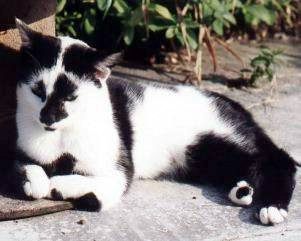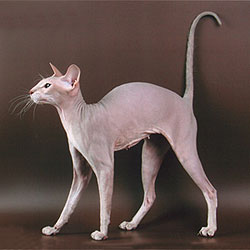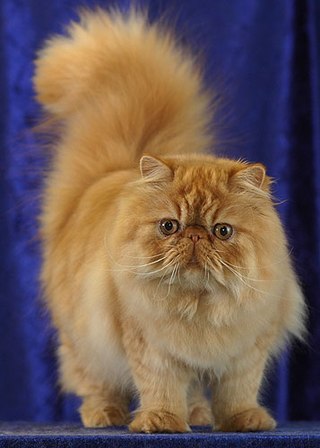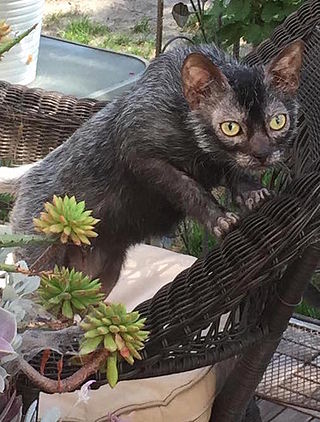
The Sphynx cat also known as the Canadian Sphynx, is a breed of cat known for its lack of fur. Hairlessness in cats is a naturally occurring genetic mutation, and the Sphynx was developed through selective breeding of these animals, starting in the 1960s.

The Scottish Fold is a distinctive breed of domestic cat characterised by a natural dominant gene mutation associated with osteochondrodysplasia. This genetic anomaly affects cartilage throughout the body, causing the ears to "fold", bending forward and down towards the front of the head. While this trait contributes to the breed's unique appearance, often described as "owl-like", it has negative effects on the cats' welfare.

The Munchkin is a breed of cat characterized by its very short legs, which are caused by genetic mutation. Compared to many other cat breeds, it is a relatively new breed, documented since 1940s and officially recognized in 1991. The Munchkin is considered to be the original breed of dwarf cat.

The Devon Rex is a tall-eared, short-haired breed of cat that emerged in England during the late 1950s. The breed is known for its atypical appearance, with an oddly shaped head, large eyes, and the short and wavy coat.

Cat coat genetics determine the coloration, pattern, length, and texture of feline fur. The variations among cat coats are physical properties and should not be confused with cat breeds. A cat may display the coat of a certain breed without actually being that breed. For example, a Neva Masquerade could wear point coloration, the stereotypical coat of a Siamese.

Pectus excavatum is a structural deformity of the anterior thoracic wall in which the sternum and rib cage are shaped abnormally. This produces a caved-in or sunken appearance of the chest. It can either be present at birth or develop after puberty.

Lordosis is historically defined as an abnormal inward curvature of the lumbar spine. However, the terms lordosis and lordotic are also used to refer to the normal inward curvature of the lumbar and cervical regions of the human spine. Similarly, kyphosis historically refers to abnormal convex curvature of the spine. The normal outward (convex) curvature in the thoracic and sacral regions is also termed kyphosis or kyphotic. The term comes from the Greek lordōsis, from lordos.

The Donskoy cat, also known as Don Sphynx or Russian Hairless, is a hairless cat breed of Russian origin. It is not related to the better-known Sphynx cat whose characteristic hairlessness is caused by a recessive mutation in the keratin 71 gene. The Donskoy's hairlessness, on the other hand, is caused by a dominant mutation.

A squitten is a cat with a genetic deformity which causes a partial formation or complete absence of the radius bone making it resemble a squirrel. These cats should be kept indoors and seen to by specialist veterinarians, as long term management of the condition is essential for quality of life in these cats. It is an example of a cat body type genetic mutation. The word is a portmanteau of squirrel and kitten.

Spondyloepimetaphyseal dysplasia, Strudwick type is an inherited disorder of bone growth that results in dwarfism, characteristic skeletal abnormalities, and problems with vision. The name of the condition indicates that it affects the bones of the spine (spondylo-) and two regions near the ends of bones. This type was named after the first reported patient with the disorder. Spondyloepimetaphyseal dysplasia, Strudwick type is a subtype of type II collagenopathies.

The Peterbald is a hairless cat breed of Russian origin. It was created in St. Petersburg in 1994 from an experimental cross of a Don Sphynx and an Oriental Shorthair. They have an Oriental build with a dominant hair-losing gene. The breed was accepted for Championship status in 2009.

A dwarf cat is a domestic cat with dwarfism due to rare genetic mutations causing a disproportionate feline body and significant health problems. Unlike undersized cats of normal proportions, dwarf cats suffer from the genetic mutations osteochondrodysplasia and achondroplasia. These genetic disorders of bone and cartilage are typically manifested as abnormal bone shape, poor growth or lack of growth, bowing of the limbs to the side – front legs are more likely to be affected, and spinal malformations.
A GALS screen is an examination used by doctors and other healthcare professionals to detect locomotor abnormalities and functional disability relating to gait, arms, legs and the spine.
Flat-chested kitten syndrome (FCKS) is a disorder in cats wherein kittens develop a compression of the thorax (chest/ribcage) caused by lung collapse. This is a soft-tissue problem and is not caused by vertebral or bony malformation. However, lung collapse can be a secondary symptom caused by bony deformity affecting the thorax such as pectus excavatum. In mild cases, the underside of the chest becomes flattened ; in extreme cases the entire thorax is flattened, looking as if the kitten has been stepped on. The kitten will appear to go from normal to flat in the space of about two to three hours, and will usually then stabilise. FCKS is frequently misdiagnosed as pectus excavatum due to inadequate veterinary literature or lack of experience with the condition on the part of the clinician.

The Minuet is a hybrid mix of Persian and Munchkin cat breeds. Categorized by The International Cat Association (TICA) as a domestic hybrid, "developed from a deliberate cross between two existing domestic breeds, incorporating characteristics of both parental breeds into the new mix." The Minuet cat is characterized by its short legs, as a result of the dwarfism-mutation derived from the Munchkin breed.

The Persian cat, also known as the Persian Longhair, is a long-haired breed of cat characterised by a round face and short muzzle. The first documented ancestors of Persian cats might have been imported into Italy from Khorasan as early as around 1620, however, this has not been proven. Instead, there is stronger evidence for a longhaired cat breed being exported from Afghanistan and Iran from the 19th century onwards. Persian cats have been widely recognised by the North-West European cat fancy since the 19th century, and after World War II by breeders from North America, Australia and New Zealand. Some cat fancier organisations' breed standards subsume the Himalayan and Exotic Shorthair as variants of this breed, while others generally treat them as separate breeds.

The Lykoi is a breed of cat derived from a natural mutation causing a form of hypotrichia found in domestic short-haired cats. The mutation has occurred in domestic cats over the last 20 years. DNA testing has been done by UC Davis to confirm that the cats do not carry the Sphynx/Devon Rex gene. The breed was developed by Brittney Gobble in Vonore, Tennessee.
Swimmer puppy syndrome is a rare condition in which dogs are born flat on their chests and abdomens, leaving them with spread eagled legs. This deformity leaves the canine unable to stand or walk. The British Bulldog is the dog breed that it found to suffer from the condition the most.















